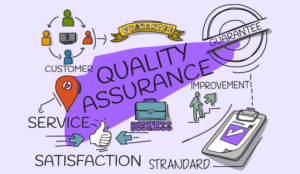Quality assurance is essential for running a successful contact centre, but not all quality assurance software is the same. Many contact centre systems include a built-in QA solution, but how effective is software that is frequently sold as an add-on, bundled in with the contact centre system?
What Is the Minimum That You Need From Your QA Solution?
It Must Be Easy to Use
Introducing a QA platform to any contact centre is going to impact the activities of not just the QA team but the agent body and the management team. A system that is easy to use and deploy is critical to delivering an effective rollout and engagement across teams.
It’s beneficial to have a combination of an intuitive interface and a comprehensive set of key features in terms of scorecards, calibration, and reporting.
Flexibility Is Non-Negotiable
If you are moving from spreadsheets to a QA solution, the system typically starts by mimicking the spreadsheet design and format. You will find that your QA needs evolve very quickly as the expanded functionality of the solution becomes apparent.
Business requirements change over time. As you gain insights into service quality and agent performance, the flexibility of the QA system and particularly the scorecards become paramount. If other departments are brought into scope for quality assurance, a completely different scorecard design will likely be needed to address the specific needs of support teams or sales teams.
Engagement and Collaboration Are Important
Critical to engagement with the QA solution is how it promotes collaboration within the evaluation and review processes. Visibility and transparency are key to agent engagement and building trust in your QA framework and processes. Dashboards and agent access are key functions to look for.
Insights That Tell a Story
A quality assurance solution’s primary goal is to deliver consistent and measurable customer service across the customer service teams. However, as part of the evaluation process, there is an opportunity to gather a rich set of data.
If you consider that information gathered on compliance, soft skills, problem resolution, and process adherence is valuable then the reports and analytics available in a solution to visualize the data and plot trends provide an opportunity to deliver real value to the management team.
The Limitations of Built-In QA Software
Many built-in QA modules bolted on to telephony, call recording or CRM (Customer Relationship Manager) platforms are restrictive. They may not support all your communications channels. They often have limited scorecard creation options and rudimentary answer choices, outcomes and feedback that could be confined to a range of one to five or only three stars.
Basic scorecards can only capture limited data which restricts the reporting capability of the system. If you only have basic data and feedback, you will have limited insights from which to make decisions about agent performance and engagement.
The level of detail you can capture and the ability to report on that detail is important when it comes to helping agent engagement and retaining agents. Limited feedback makes it harder to provide the best direction and coaching for agents.
Poorly coached agents can have a detrimental effect on Customer Satisfaction Score (CSAT) and Net Promoter Score (NPS) ratings, affecting the company’s bottom line. Agents can become disillusioned and leave. Losing staff is an expensive process and they can be hard to replace.
These limitations can be exacerbated as your company grows. Purpose-built QA systems, developed by specialist companies, are less likely to be subject to the same restrictions and limitations of a built-in system.
They include more flexibility and innovation, can be upgraded and enhanced more often and offer more options than their built-in competitors. Contact centres can get more from purpose-built QA systems that can create more complex scorecards and provide much better feedback to agents.
4 Questions to Ask About Your Call Centre QA Solution
How Do I Know My Agents Are Compliant?
Call centres are under strict compliance obligations around data, its transfer, usage and storage. Is the QA solution up to date and able to manage these obligations? As consumer and data protection regulation spreads, monitoring compliance and alerting breaches is increasingly demanded.
Can the QA system automatically track compliance performance and highlight failures as they happen, alerting a line manager? Can it enable you to show auditors how you are monitoring and dealing with compliance breaches and reduce your risk profile?
Can It Provide Effective Text Analytics?
Text analysis is becoming a crucial component of QA that helps to provide better customer service by focusing on targeted conversations.
With growing demand from customers for text and chat-based interaction, it is important the QA system can review every text-based channel – such as live chat, email, voice transcripts, and customer support tickets—to provide a holistic view of the customer experience.
Text analytics enables you to spot trends, understand the percentage of users with a particular issue and improve products, services and customer support.
You can use text analytics to assess the customer’s perception of an interaction with the contact centre and identify sentiment trends for each agent and as a whole. You can identify overarching areas for improvement, agents in need of training and agents that deserve rewards.
Can People Use It?
Software is the bedrock for effective quality assurance, but it needs to work for everyone who uses it. The QA software needs to be user friendly. You need to be able to trial the software to see how easy or difficult it is for agents to use.
Some training may be required but it should not take up too much time. Day-to-day users should be able to use the software as well as senior management and coaches.
The software should allow contact centre managers to edit forms quickly and easily. It should be easy to add and remove users because this is a common requirement for contact centres and you need to be able to make these edits quickly and simply. Finally, how long will it take the IT team to set it up?
Does Your QA System Support Remote Working?
Remote work became the new normal for many organizations during the pandemic and is likely to remain so for a large number of them into the future.
With 62% of contact centres planning to implement cloud technology, your QA software will need to be up to the challenge presented by the shift in working patterns and needs to be able to provide the same flexibility and user experience as in pre-pandemic times.
Purpose-built QA systems are, by definition, far more flexible than built-in systems and able to integrate with a much wider range of contact centre solutions.
Get the Best From Your Contact Centre
It is important that your organization makes the best choice for the business when deciding which contact centre QA software to implement. Built-in QA software might seem like a low-cost option, but in many instances, it may be more of an afterthought than a dedicated product.
Purpose-built QA software is designed to help you turn QA into a strategic asset, improve your customer service delivery and get the best from your contact centre today and into the future.
This blog post has been re-published by kind permission of Scorebuddy – View the Original Article
For more information about Scorebuddy - visit the Scorebuddy Website
Call Centre Helper is not responsible for the content of these guest blog posts. The opinions expressed in this article are those of the author, and do not necessarily reflect those of Call Centre Helper.
Author: Scorebuddy
Published On: 8th Mar 2022 - Last modified: 27th Apr 2022
Read more about - Guest Blogs, Scorebuddy






 Scorebuddy is quality assurance solution for scoring customer service calls, emails and web chat. It is a dedicated, stand-alone staff scoring system based in the cloud, requiring no integration.
Scorebuddy is quality assurance solution for scoring customer service calls, emails and web chat. It is a dedicated, stand-alone staff scoring system based in the cloud, requiring no integration. 






























